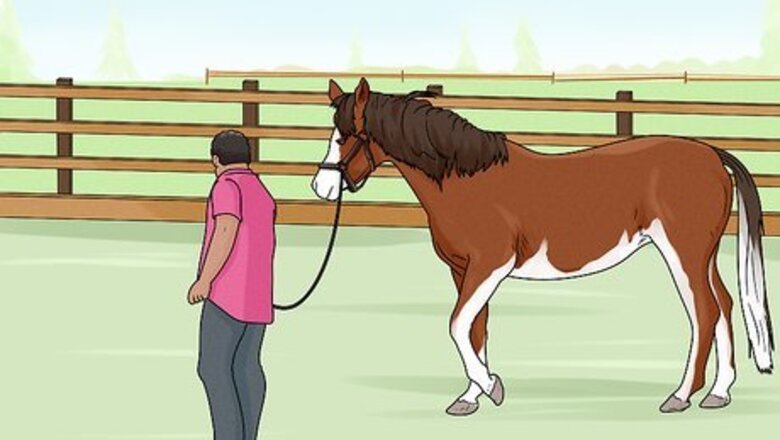
views
Setting up Your Equipment
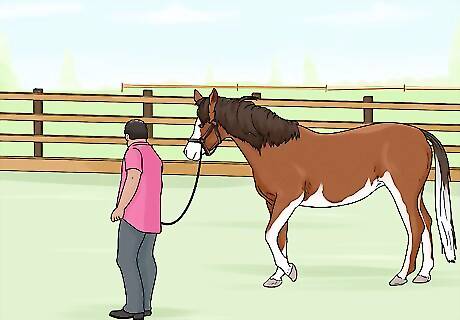
Bring the horse into a ring or an enclosed pasture. In general, you’ll need a space that’s about 14–15 m (46–49 ft) for your horse. This will give it enough room to trot, but not so much room that it will feel like it’s out at the open, which might make the horse try to escape. If you don’t have a ring, try using bales of hay to make a circle instead.

Apply polo wraps to the horse if you want to protect its legs. Lunging is a physical workout for your horse. To help protect it from injuries, you may want to wrap a special athletic bandage, known as a polo wrap, around the horse’s ankles. Start about 2/3 of the way up the horse’s leg, then wrap down toward the ankle. The bandage should be tight, but not snug. Loop the bandage under the fetlock and continue wrapping back up the leg, then fasten the wrap with velcro. Wrapping your horse’s ankles in polo wraps can help protect their feet and ankles from injury if it stumbles on the lunge line. It can also prevent injuries caused by an improper gait, which is especially a risk for a green horse. You can also use sports boots on the horse if you prefer them.
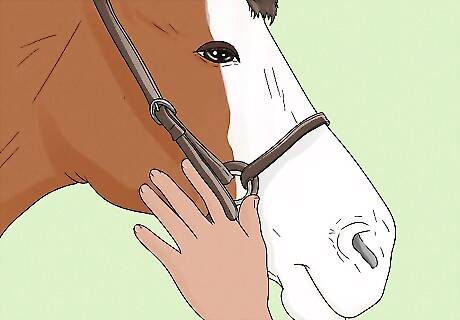
Place a lunge cavesson onto your horse if you have one. A lunge cavesson is a special piece of headgear that allows you to control the horse without causing it discomfort. Place the cavesson so it fits snugly across the horse’s nose without slipping. Also, make sure it rests above the soft tissue to allow the horse to breathe freely. You can find lunge cavessons and reins wherever horse supplies are sold. Tip: If the horse is wearing a bridle, you can place the cavesson over the bridle.

Snap the lunge rein to the center ring of the cavesson. A lunge rein is a long rein that clips to the cavesson. They’re typically made from webbing or another lightweight material to make them easy to handle. You’ll use the rein to guide the horse in a wide circle, so it needs to be long enough to allow the horse to reach the outer edge of your enclosure. If you don’t have a lunge rein, use a strong rope or flat webbing that’s about 8.5 m (28 ft) long.
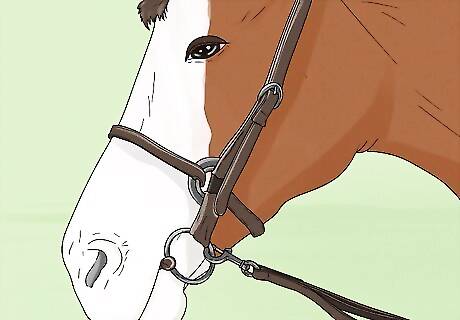
Clip the rein to a harness if you don't have a cavesson. While a lunge cavesson does make it easier to attach the lunge rein comfortably, you can still lunge if you don't have one. Just settle the harness low on the horse's head and clip the lunge rein to the inside of the harness. Never attach the lunge line to the horse's bit. This could cause the rein to pull painfully on the horse's mouth.
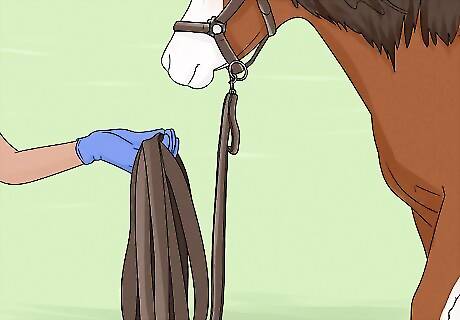
Fold the excess lunge line back and forth on itself and hold that in your hand. When you're handling the lunge rein, take the time to fold it neatly in accordion-style pleats. Folding the reins will help keep any excess from getting tangled, and it will make it easier to hold. Never fold the coil the line around your hand. If the horse bolts, the line could pull tight around your hand, causing you serious injury.
Starting the Lunge
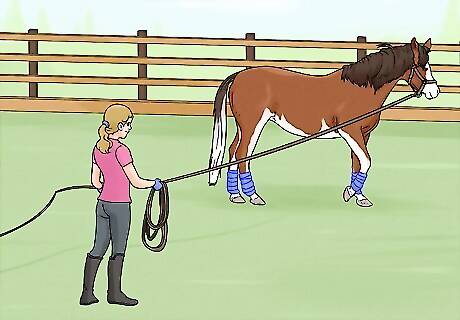
Stand in the center to the ring, holding the lunge rein and a whip. When you’re ready to start lunging your horse, guide it to the ring, and stand right in the middle. Carry the whip and the excess lunge rein in the hand that’s closest to the horse’s backside, and use your free hand to control the rein and take up or loosen the slack. Imagine making a triangle where the horse’s body is the base and the whip and lunge rein are the sides. For example, hold the lunge rein and the whip in your right hand if you want the horse to go left, and use your left hand for adjusting the reins. Carry the whip so it's pointing behind the horse and down when you're not using it. Also, try to keep the whip still, since it will be less effective if you’re constantly flicking it. Try to face the middle of the horse, since staring at the horse’s face could make it feel stressed.
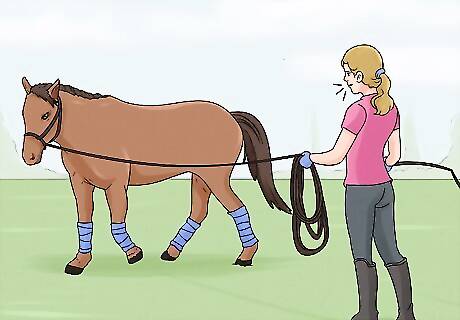
Give the horse a command to start walking. You can use any word or sound you want to command your horse to walk, but make sure you’re consistent. For instance, if you make a clicking sound to get your horse to walk, that should be the sound you use every time.Common Horse Commands: You could say "Whoa" to get the horse to stop immediately, say a long “Trot” sound to speed up to a trot, and make kissing sounds to go into a canter. Use very distinctive tones for each command, and try to keep your verbal commands to a minimum. If you’re constantly talking, the horse will start to tune out your voice.
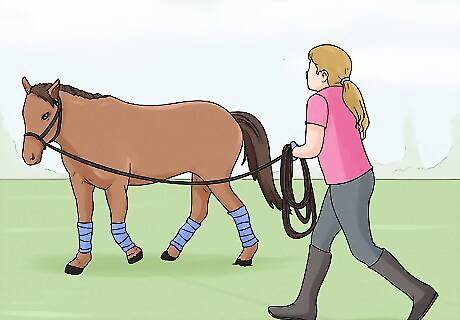
Move the horse out by having it walk as you let out some slack in the rein. Let the slack out a little at a time, and try not to let it drag on the ground too much, or the horse might get tangled up in it. Keep your elbows soft, so it feels like the line is elastic. If you hold the rein too tight, the horse will start to resist you. Let the horse walk around the circle about 3-4 times. You can either stand on one spot and turn as the horse walks the circle, or you can walk around in a small circle.

Move to a trot for about 15 minutes. After the horse has walked 3-4 circles, it’s time to pick up the speed to a trot. Give the horse your command for trotting, and make sure to turn at the same speed as the horse so you don’t get tangled in the lunge line. Use the whip if you need to correct the horse’s speed during the session. Most of your lunging session should be done at a trot. If the horse is experienced with lunging, or if it’s done very well with the session, you can move to a canter for a few minutes at the end. If the horse seems winded or lame, you can stop the session sooner.
Using the Reins and Whip to Command the Horse
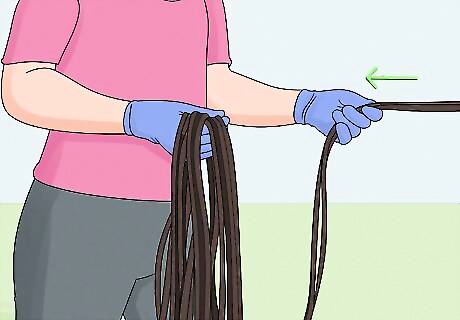
Speed up the horse by pulling the lunge rein forward slightly. Hold your arm out so the lunge rein is pulling toward where the horse is going, rather than straight out from the horse. At the same time, bring the whip up and hold it closer to the horse’s hindquarters. This should encourage the horse to speed up slightly. Lower the whip once it does so. You can also include a verbal command or a sound like a clicking noise to tell the horse what you want.

Point the whip at the horse's shoulder to keep it from turning in. When you’re lunging a horse, it’s important to keep it from walking in to the center of the circle. Not only does this defeat the purpose of the exercise, but it also creates slack in the line that the horse could trip over. To prevent the horse from turning in, point the whip at the horse’s shoulder, or lightly touch the horse on the shoulder with the whip. This should encourage it to move back toward the outside of the circle. You don’t necessarily have to give the horse a command
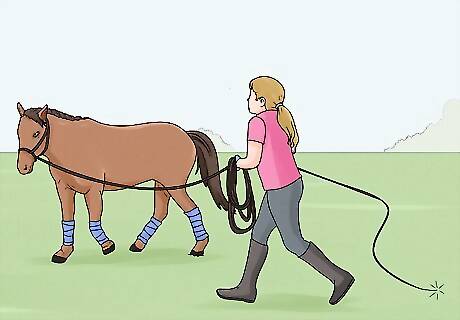
Flick or crack the whip only when necessary. The whip is a simple training aid that’s there to allow you to direct the horse while remaining out of kicking distance. For situations when a horse is deliberately misbehaving, you can flick or crack the whip, but try not to do so unless you need to. If you move the whip around too much, the horse will start to ignore it. Never use the whip to hit or scare the horse. It will lose its trust in you, and you’ll likely have escalating behavioral problems from the horse.

Apply consistent pressure to the reins if the horse won’t cooperate with you. The horse should start trying to figure out what to do in order to get you to release that pressure. When the horse behaves how you want it to, ease up on the pressure. That way, it will know exactly what was expected of it, and it will be more likely to do that behavior in the future. Don’t yank hard on the lunge rein. You could hurt the horse or cause it to buck, which could lead to an injury.
Stopping the Horse

Bring the horse back down to a walk, then stop without pulling the horse in. After about 15 minutes of trotting in circles, give the horse a command to slow to a walk. However, don’t pull the lunge rein to bring the horse in toward the center of the circle. Instead, bring the horse to a full stop at the end of the lunge line. Turn the horse to the outside of the circle before you unclip the rein. If you walk the horse into the center of the circle, it will want to come in toward you every time you slow to a walk when you’re lunging.
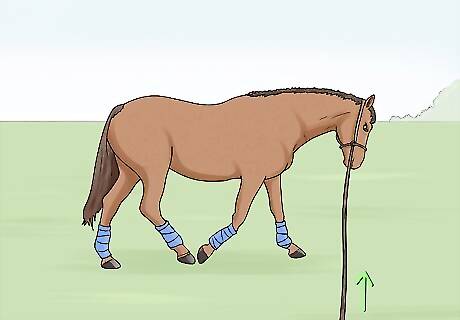
Slow the horse by bringing the lunge rein back slightly. If the horse starts going too fast, hold the rein so it’s pulling slightly back toward the horse’s neck. Hold the whip down and away from the horse. Use a command like “Walk” to tell the horse to slow as you pull on the rein. Tip: If you hold the whip too close to the horse, it will resist slowing down. To the horse, if it keeps going faster, it will be able to get away from the whip.
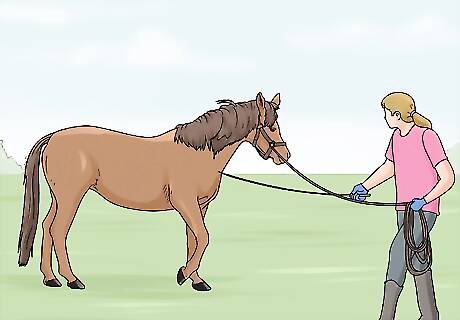
Point the whip in front of the horse to stop it once it has slowed down. Once you've brought the lunge reign back and your horse has slowed to a walk, maintain pressure on the rein, then move the whip so it’s in front of the horse. This should indicate to the horse that you want it to stop. Wait until the horse slows before you place the whip in front of it. Otherwise, the horse could become startled, especially if it's whip-shy. The horse could rear back and get tangled in the lunge rein, which would be dangerous for both you and the horse. Try saying “Whoa” at the same time you stop the horse.
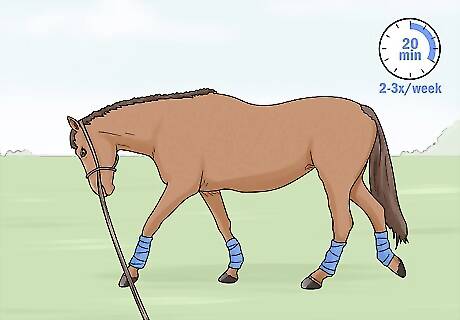
Lunge your horse 2-3 times a week for 20 minutes at a time. Lunging your horse is a great workout, and it helps to reinforce your horse's training. While there are no set guidelines for how often to lunge your horse, 2-3 times a week is a good guideline, especially if you can't ride every day. This will help keep your horse in good shape, and it will improve the bond between you and your horse, since you'll be spending quality time giving it instruction. You may also want to lunge your horse before you ride it, especially if it's been a while since your last ride. This can help remind your horse of some of its training basics, and it can help get the horse in a compliant mindset before you mount up. If your horse hasn't exercised in a while, start by lunging 1-2 times a week, then work your way up as the horse gets more comfortable.



















Comments
0 comment